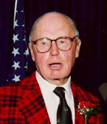I just learned that Geoffrey Cornish, one of the most influential golf course architects of the last one hundred years, died this morning in Massachusetts, where he had lived for most of his adult life. Residing in the village of Fiddlers Green, outside of Amherst, Geoff walked almost every day when he was home in the Lawrence Swamp, setting a vigorous pace even in his seventies and eighties. He and his wife, Carol, who was an avid gardener, had no children, but they preserved a priceless archive of materials related to the history of golf course design, including plasticine models that Geoff’s close friend, Robert Trent Jones, who apprenticed to Stanley Thompson along with Geoff in the 1930s, molded in order to show the workers building his golf courses what he wanted the greens to look like. Plans for golf courses were much simpler when Trent Jones and Cornish joined the profession, and Geoff was a direct link to golf’s earliest history in North America.

Geoffrey Cornish. A Great Gentleman and an Influential Presence for Seventy Years in Golf Course Design
Geoff’s curiosity about the history of golf course design led to a long collaboration with Ron Whitten, the architecture editor of Golf Digest, which resulted in their 1981 encyclopedic treatise on golf architecture, “The Golf Course,” which would be updated in an edition published by HarperCollins in 1993 and re-titled “The Architects of Golf.” About a third of the book consists of mini-bios of almost anyone who had a hand in designing a golf course in the 20th century. Geoff always treated everyone in the profession with great respect, in keeping with his graceful personality and generous spirit, and these profiles illuminate his magnanimous character.
With his close friend Robert Muir Graves, Geoff taught a seminar every year at the Harvard Graduate School of Design for aspiring golf course architects and land planners. I took the course in 1988 and have the certificate hanging on the wall behind me as I write this. (Jan Beljan, a long-time associate of Tom Fazio and one of the few prominent women in golf course design, was one of my classmates.) Geoff and Bob did a fabulous job with the course, and summoned all of the wisdom from their many years of designing courses and teaching when they collaborated on a textbook called “Golf Course Design.” Along with Mike Hurdzan’s “Golf Course Architecture,” it’s the classic treatment of an arcane subject.
Geoff had a professorial air, but he was also witty and tough. He had landed on the beaches of Normandy as an officer in the Canadian Army Overseas, which he joined, as I recall, in 1939, when war first broke out in Europe. He was then already 25 years old. Born in Manitoba, he had started his career in golf in British Columbia, working both in agronomy and design. His professional training was in agronomy, and he learned golf design on the job. He revered Trent Jones, and regarded him as the fountainhead of modern design, but he also had an irreverent streak, and enjoyed remembering how difficult it was for Jones, a city boy, to learn how to move dirt behind a mule and a shaping pan when they were building courses together for Thompson. Hard work was easy for a boy from Canada’s western plains.
Geoff was a kind of Johnny Appleseed of golf in New England, and his influence spread to the west through his colleague, Bill Robinson, who moved to Oregon in the 1970s and continued the Cornish tradition of designing solid, easy to maintain, uncomplicated golf courses that the average golfer enjoyed playing. Another Cornish protégé, Brian Silva, has also gone on to have a distinguished career. Geoff continued to work with Mark Mungeam in Cornish Mungeam Design, staying active well into his 90s.
During the go-go years in golf architecture of the 1990s and beyond, when Trumped up golf courses with waterfalls and ostentatious “design features” seemed to push golf into unsustainable realms, the modest approach of Geoff Cornish seemed quaint and outmoded. But in the melt-down of the post-recession era, Geoff’s approach suddenly seemed sensible and responsible again, just like the man.
